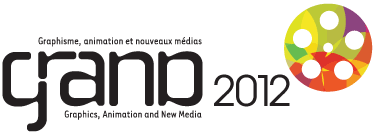Mash-ups: Session 1 - Thursday May 3, 3:15pm-4:15pm
Track A: SKETCH Highlights
Organizer: Faramarz Famil Samavati, Computer Science, University of Calgary
Participants: Faramarz Famil Samavati, Computer Science, University of Calgary
Karan Singh, Computer Science, University of Toronto
Alla Sheffer, Computer Science, University of British Columbia
David Mould, Computer Science, Carleton University
Sandrine deRibaupierre, Neurosurgery, University of Western Ontario
Roy Eagleson, Engineering, University of Western Ontario
Sheelagh Carpendale, Computer Science, University of Calgary
Sketch-based interfaces are the natural communion of tactile input and a universally understood medium of visual communication that mimic traditional metaphors of drawing, painting, and gesturing. In computer graphics, the creation of digital content, geometric models and animation, have traditionally been the domain of skilled experts interacting with complex software packages that are tedious and challenging to use. With the increasing emphasis on user-driven content creation, computer graphics is changing from a medium which is created by experts and consumed by the masses, to a medium in which all aspects of digital content are accessible to a broader public. While the sentiment of “everyone can draw” may not be strictly accurate, there is a universal desire and capacity for visual communication through sketching: a few quick pencil strokes can often convey complex shapes and motion. Coupled with the increasingly widespread use of devices that support tactile input, such as the Tablets, SmartBoard, iPhone, Tablets and Nintendo DS, interfaces and algorithms that infer user interaction, creation of 3D models and animation from 2D sketch strokes will change the way such content is created and consumed. In a more abstract setting, sketching has the potential for complex gestural communication, especially when combined with the affordances of tactile input such as speed, pressure or pen tilt. Research on approaches that exploit this information in various contexts will result in interaction vocabularies that are both more powerful and natural to users than current interfaces. In the past year our researchers have been making steady progress on various sub-projects related to SKETCH. It has been a strong and fast growing collaboration among PNI/CNI of this project across Canada; and an active collaboration with relevant industries. In SKETCH mash-up some of papers that describe recent work in this project will be presented.
Track B: Using Video Games as Treatment for Children with Neurological Disorders
Organizer: Nicholas Graham, Computer Science, Queen's University
Participants: Bruce Gooch, Computer Science, University of Victoria
Nicholas Graham, Computer Science, Queen’s University
Regan Mandryk, Computer Science, University of Saskatchewan
James Reynolds, Biomedical and Molecular Sciences, Queen’s University
Neurological disorders including cerebral palsy, fetal alcohol spectrum disorder and autism spectrum disorder affect hundreds of thousands of Canadians. Treatments for these disorders can be repetitive and tedious, making compliance difficult. The NEUROGAM project brings together researchers from the GRAND and NeuroDevNet NCE’s to collaboratively explore how video games can help in the treatment of neurological disorders in children. During the mash-up, we will hear from researchers discussing how video game-based exercise can help in regeneration of brain structures in children with FASD, how games can help train children in the regulation of disruptive emotions, and how games can help improve physical fitness and social connectedness of children with cerebral palsy. The subprojects within NEUROGAM each bring together specialists in neurological disorders from NeuroDevNet with specialists in digital gaming technology from GRAND. We will discuss how this unique collaboration is resulting in the development of novel technology and treatment techniques that are being tested in clinical settings.
Track C: Intellectual Property Issues
Organizer: Paul Kry, Computer Science, McGill University
Participants: Philippe Beaudoin, Software Developer, Google
Eugene Fiume, Computer Science, University of Toronto
Gordon Kurtenbach, Director of Research, Autodesk
Katie Young-Morris, Venture Development Manager, TandemLaunch
Paul Kry, Computer Science, McGill University
Michiel van de Panne, Computer Science, University of British Columbia
There are many technologies in computer graphics, animation, and games that are the result of collaborative research. An important objective in GRAND NCE research projects is to continue this tradition; however, there are choices to make with respect to intellectual property, with varying consequences for industry collaboration and academic impact. This panel will be a discussion concerning choices available, from free and open source licenses to software patents. The panelists will address questions on the advantages and disadvantages of taking these different paths, implications, challenges, and benefits of each.
Track D: Ludic engagement as "real" research
Organizer: Lynn Hughes, Fine Arts, Concordia University
Participants: Jason Camlot
Lynn Hughes, Fine Arts, Concordia University
Geoffrey Rockwell
Cindy Poremba
Ron Wakkary
Emma Westecot
"It is now cheaper to just try something than to sit around and try to figure out whether to try something. The compass has replaced the map."
Joichi Ito, Director, MIT Media Lab in the NY Times.
PlayPR is an example of a GRAND project where a very significant part of the activity is practice-based, and prototypes and play testing are central rather than peripheral to research outcomes and activities. What role can interactivity and ludic engagement play alongside more traditional approaches to research in the context of GRAND? What is the appeal and what are the potential benefits, for research and teaching, of a research model in which design and interactivity are central.


